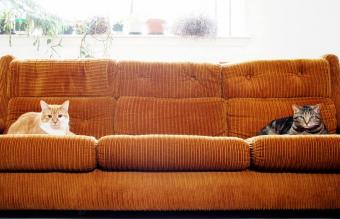
Sometimes, you need to keep cats off furniture or away from certain areas in your home, like kitchen counters. One effective way to do this is to combine behavior modification using positive reinforcement with some simple and safe homemade cat repellents.
Repellant vs. Other Methods
The best way to keep a cat away from areas you do not want them to get into is to block their access completely, such as with a closed door. However, that's not always possible with how homes and apartments are laid out. Using a cat repellant can deter your cat from going into areas you want them out of or jumping on, but it will only be truly effective if you provide your cat with an equally desirable place for him to go (more on this later).
Homemade Cat Repellent Options
Most of these cat repellents can be made cheaply with some supplies available at your local grocery store, hardware store, or craft store. Make sure you use items that are safe for your cat, as you want the repellent to be annoying but not harmful or toxic in any way.
1. DIY Cat Spike Mat
This repellent works by making a surface your cat will not enjoy walking on and placing it as a barrier around off-limits areas, like house plants or your counters. For this repellent, you will need these supplies:
- Tape: Double-sided tape, sticky on both sides and three inches wide
- One plastic floor chair mat: This is the kind of mat you put under an office chair and is clear on top with plastic points on the bottom. Make sure the points are rounded, as you want them to be uncomfortable for the cat but not sharp enough to hurt him.
- Scissors: Good, sharp scissors to cut through the plastic floor mat.
To make the cat spike mat, follow these steps:
- Boundaries: First, you'll need to find all the places you do not want your cat to go. Make a map or floor plan of where you are going to set your boundaries. Remember, this is not forever, but long enough to train your cat.
- Place tape: Once you have your plan, you want to cut your tape and place it on the floor where you do not want the cat to go.
- Plastic mat: Cut the plastic mat to the same width as the tape you just cut, and put it on top of the tape. Make sure to place it upside down with the plastic tips pointing up.
@tuxedoandfloof She’s so disappointed#scatmat#catmat#houseplants#catsdestroyingthings#spiderplant#catsbeingcats#weirdhabit#weirdcatsoftiktok#disappointed#calicocat ♬ Maniac (Flashdance Version) (Re-Recorded / Remastered) - Michael Sembello
2. Scent-Based Cat Repellents
Another way to deter cats from accessing certain areas is to use scent. There are many scents, like lavender and citrus, that humans find pleasant, but cats find offensive and will avoid. These repellents can be used to keep cats away from any area, such as counters, your Christmas tree, or house plants, but they may not be as effective.
Some common scent repellents include:
- Cinnamon mixture: A mixture in a spray bottle of cinnamon, rosemary, lavender, tangerine, and vinegar.
- Apple cider vinegar: A solution of equal amounts of apple cider vinegar and water in a spray bottle.
- Lemon spray: Spritz a small amount of fresh lemon or orange juice in a spray bottle with two drops of eucalyptus oil.
Another option is to put any of these solutions in a small essential oil-friendly diffuser and put it in the area you want your cat to avoid.
Do not use essential oils as deterrents for your cats, as these can be toxic.
3. Avoid Using Noise Repellants
Some cat owners make "noise traps" by placing items that will make a loud sound if your cat goes into the area. These are commonly used on areas that a cat is jumping onto but can't see the surface of from the bottom, such as a kitchen counter. Items might be a few metal utensils, balloons, empty soda cans, marbles, or pots.
The problem with these traps is that they may seriously frighten your cat, which can cause other behavior problems. Not to mention, they can damage your floors, depending on what you use and the flooring you have. Your cat may also hurt themselves by leaping off the counter in fear.
4. Aluminum Foil As Cat Repellant
Along the same lines as the cat spike mat, you can place items around areas your cat shouldn't be going that your cat will avoid walking or jumping on. Aluminum foil is one substance that cats dislike, and placing sheets of it around a house plant or on the edges of a counter can be a deterrent to some cats.
Using a Cat Repellent Effectively
Once you've made your cat repellent and placed it where you want the cat to stay away, provide a place for your cat that they'll love. Some excellent ideas are cat scratching posts, multi-tiered cat trees, cat shelves on the wall, window perches, and tunneling toys.

Some cats will even go nuts over a simple used cardboard box, which can work out if you have the space and don't mind it sitting around your house.
Follow these steps once you've created a spot, or several spots, for your special kitty:
- Bring the kitty: Take your cat to their "happy place" a few times a day.
- Make it fun: Talk to them in a happy voice, brush them, play with toys, and give them treats there. Basically, you want to use whatever they love most to show them that this is an awesome place to hang out.
- Catnip: Rub the area with catnip as well to make it extra enticing.
- Reinforcement: Whenever your cat goes near the undesirable place when you're home and can supervise, simply pick them up quietly, take them to the "happy place," and reinforce that good things happen here.
- Patience: Be patient, as this process can take some time, but eventually, your cat will want to be where good things happen and avoid places that are unpleasant to be in.
Cats hold grudges, so it's important to train them carefully. According to National Geographic, "Cats don't forgive, and once they realize a person is causing them anxiety or hurt, they keep away."
Redirect Your Cat
Whether store-bought or homemade, cat repellents can do a good job of keeping your cat out of places and away from your furniture, but they're only as good as your training plan. This means providing your cat with alternate "approved" kitty spots that they will find enjoyable and teaching your cat with patience and positive reinforcement. If you're consistent and work with your cat's unique personality, you should have your cat gravitating toward their "happy place" soon enough!







